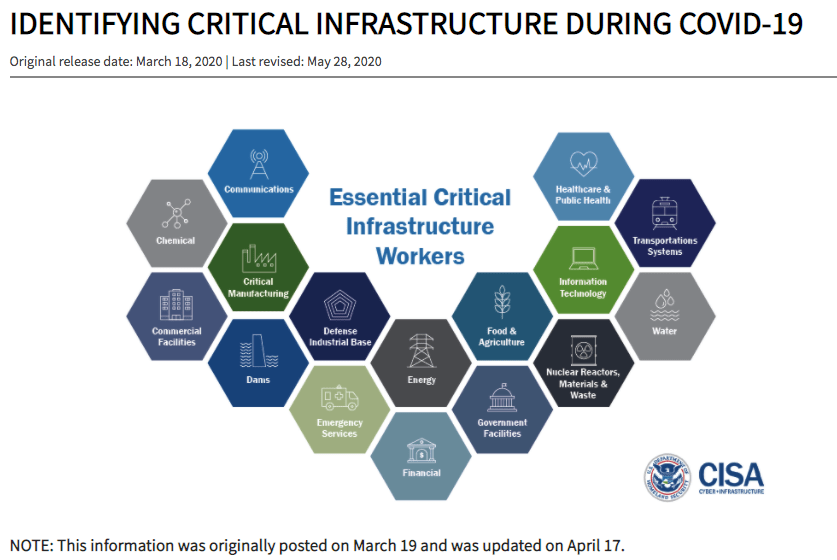By Shannon Broome
As California continues on “stage 2” of reopening during our third month of Shelter-in-Place orders throughout many California counties, companies that are operating as part of the essential infrastructure of the state are continuing to implement appropriate measures to keep operating and also face challenges with respect to the myriad regulations that apply to their day-to-day operations. The challenges sit at the intersection of environment, health and safety, and economics. Staying afloat is vital to the health and well-being of employees and their families, and the broader communities where they purchase food, support stores and restaurants, and the like, while their presence in the workplace is vital to maintaining compliance with environmental, health, and safety regulations, that protect both operations and communities in which the companies operate.
Like the imposition of smallpox vaccine requirements a century ago, Jacobson v. Massachusetts, 197 U.S. 11 (1905), the government entities issuing these orders are doing so with the aim of promoting the public good. No doubt, however, they impose hardship on businesses and citizens alike. California’s state and county orders directed nearly 40 million California residents to “stay home” — “except as needed to maintain continuity of operations of the federal critical infrastructure sectors.” Without exception, these orders exempt individuals performing “Essential Activities,” which include “work necessary to the operations and maintenance of “Essential Infrastructure” and the operation of “Essential Businesses.”
What is an “essential business” and “essential infrastructure”?
The statewide order allows Californians working in critical infrastructure to continue their work and applies to the federal critical infrastructure sectors outlined by the federal Cyber Infrastructure Security Administration (CIFA) in its guidelines for “Identifying Critical Infrastructure During COVID-19.” (See image.) The critical infrastructures include chemical, critical manufacturing, energy, transportation systems, and waste & wastewater systems sectors. The energy infrastructure sector explicitly includes “electricity, oil, and natural gas.”
 Counties’ “shelter in place” orders similarly allow such essential infrastructure and the essential businesses supporting them to operate provided that they carry out those services in compliance with Social Distancing Requirements. “Essential Businesses” include “[b]usinesses that supply other Essential Businesses with the support or supplies necessary to operate.”
Counties’ “shelter in place” orders similarly allow such essential infrastructure and the essential businesses supporting them to operate provided that they carry out those services in compliance with Social Distancing Requirements. “Essential Businesses” include “[b]usinesses that supply other Essential Businesses with the support or supplies necessary to operate.”
As a business that qualifies for continued operation, which workers are able to come to work for their functions?
CIFA’s guidance lists sectors and essential workers for “prioritizing activities related to continuity of operations and incident response.”¹ Workers in the chemical and manufacturing sector infrastructure are similarly exempt and include transportation, energy, communications, food, and other essentials of daily life.
What about regulatory requirements like emission and discharge limits and monitoring and reporting requirements?
Permit requirements and regulatory limits continue to apply unless removed through the regulatory process or unless the regulations provide an applicable emergency or malfunction defense. This means that if violations occur during the COVID-19 crisis, either because of it directly or because reporting deadlines are missed due to work schedule disruption, they need to be reported under a permit term or applicable regulations.
To their credit, regulators have recognized the disruption companies in critical industries face, communicating that they will exercise enforcement discretion in such cases. “Enforcement discretion” means that although a regulator could initiate enforcement, it exercises its discretion not to do so based on the circumstances. For example, one regulator communicated that although operations at the agency are “business as usual,” face-to-face meetings are suspended and advised “facilities to do what is necessary to protect business operations and the health and safety of staff during these times.” It stated that if “doing so results in instances of non-compliance,” companies can explain the circumstances and decisions on enforcement will consider the information. Not exactly a guarantee, but a definite acknowledgment that the circumstances are being considered.
Similarly, California’s State Water Resources Control Board issued a directive on compliance with their regulatory requirements, reaffirming companies must comply with all Water Board orders and other requirements. But, it encourages companies to communicate about compliance issues and commits to responding within 48 hours.
Other relief for companies could be available in the form of emergency and longer-term variances, which are typically used for things like process upsets, but the extensive procedures to qualify for such relief must be followed.
U.S. EPA and other states have issued similar guidance. Even with these assurances, companies should be aware that their current actions will be viewed in 20/20 hindsight, which counsels in favor of making all reasonable efforts to comply consistent with the health and safety of employees and the public. If compliance will not be achieved, communicating and documenting the reasons for non-compliance while meeting any immediate reporting requirements for deviations from permit or regulatory requirements.
What about environmental and other regulator inspections?
Most regulators are suspending in-person inspections and if one is to occur, are at least providing advance notice. Companies should remember that agencies must conduct inspections “in compliance with Social Distancing Requirements” and all other requirements apply (e.g., requiring inspector credentials, escorting the inspector (safely distanced)), as for any other inspection. COVID-19 should not alter these normal inspection procedures.
The bottom line is a rule of reason should be applied — and documenting your decisions is the key, including your communications with regulators and their responses (orally or in writing). All of this documentation will prove critical should the company face enforcement for failure to meet obligations during the crisis.
References
1 https://www.huntonnickelreportblog.com/2020/03/socially-distant-operation-of-california-infrastructure/#_ftn1
 Broome is the managing partner of Hunton Andrews Kurth’s San Francisco office and leads the firm’s California environmental practice.
Broome is the managing partner of Hunton Andrews Kurth’s San Francisco office and leads the firm’s California environmental practice.
Want more news about COVID-19 and its impact on facilities management?
Click here to read more news related to the coronavirus pandemic and facility management.




















![[VIDEO] Collect Asset Data at the Speed of Walking a Building](https://facilityexecutive.com/wp-content/uploads/2024/02/maxresdefault-324x160.jpg)